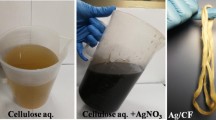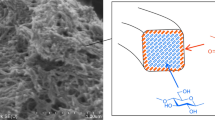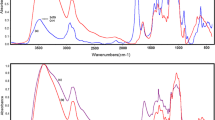Abstract
Composite cellulose hydrogels result from physical or chemical crosslinking processes. Unique tridimensional architectures, arising from the hydrogel components’ interactions, make these materials ideal to design function-driven structures. We follow the development of cellulose nanofiber/silver nanoparticle (Ag NP) hydrogels in aqueous media. TEMPO-oxidized cellulose nanofibers (TOCNs), extracted from fique residual biomass, acted as both capping and reducing agents for the in-situ synthesis of Ag NPs. Temperature and COONa:AgNO3 molar ratios influence hydrogel formation. Increasing temperatures (60 ºC) resulted in shorter reaction times (28 h) compared to the behavior at lower temperatures (25 ºC), which required longer reaction times (192 h). High COONa:AgNO3 molar ratios (1:3) produced stiffer and darker TOCN/Ag NP hydrogels at the expense of large cubic Ag NP clusters formation (1 µm). Conversely, lower COONa:AgNO3 molar ratios (1:1) resulted in softer hydrogels with spherical Ag NPs exhibiting diameters between 15 and 80 nm. Ag NP formation and crosslinking processes strongly depend on unreacted aldehydes on the TOCN surfaces after the TEMPO oxidation reaction. IR spectra indicated that there is a bridging bidentate interaction between COO− groups and Ag+ ions. These carboxylate-metal complexes might weaken the hydrogen bond system by increasing the distance between cellulose molecules, decreasing the material’s crystallinity index, as observed in XRD analyses. TGA analyses demonstrated that Ag NPs significantly increased the TOCN/Ag NP hydrogels’ thermal stability compared to TOCN hydrogels. Rheological probing of the hydrogels elucidated the role of Ag NP distribution and loading on the elastic response to cyclical deformations, suggesting a myriad of uses for these materials, particularly in medicinal applications.
Graphic abstract






Similar content being viewed by others
References
Abdul Khalil HPS, Davoudpour Y, Islam MN et al (2014) Production and modification of nanofibrillated cellulose using various mechanical processes: a review. Carbohydr Polym 99:649–665. https://doi.org/10.1016/j.carbpol.2013.08.069
Abraham E, Deepa B, Pothan LA et al (2011) Extraction of nanocellulose fibrils from lignocellulosic fibres: A novel approach. Carbohydr Polym 86:1468–1475
Adkins H, Elofson RM, Rossow AG, Robinson CC (1949) The oxidation potentials of aldehydes and ketones. J Am Chem Soc 71:3622–3629. https://doi.org/10.1021/ja01179a012
Al-Azri ZHN, Chen W-T, Chan A et al (2015) The roles of metal co-catalysts and reaction media in photocatalytic hydrogen production: Performance evaluation of M/TiO2 photocatalysts (M = Pd, Pt, Au) in different alcohol–water mixtures. J Catal 329:355–367. https://doi.org/10.1016/j.jcat.2015.06.005
Araki J, Hida Y (2018) Comparison of methods for quantitative determination of silver content in cellulose nanowhisker/silver nanoparticle hybrids. Cellulose 25:1065–1076. https://doi.org/10.1007/s10570-017-1640-z
Beaumont M, König J, Opietnik M et al (2017) Drying of a cellulose II gel: effect of physical modification and redispersibility in water. Cellulose 24:1199–1209. https://doi.org/10.1007/s10570-016-1166-9
Biliuta G, Coseri S (2019) Cellulose: a ubiquitous platform for ecofriendly metal nanoparticles preparation. Coord Chem Rev 383:155–173. https://doi.org/10.1016/j.ccr.2019.01.007
Calderón-Vergara LA, Ovalle-Serrano SA, Blanco-Tirado C, Combariza MY (2020) Influence of post-oxidation reactions on the physicochemical properties of TEMPO-oxidized cellulose nanofibers before and after amidation. Cellulose 27:1273–1288. https://doi.org/10.1007/s10570-019-02849-4
Cao X, Ding B, Yu J, Al-Deyab SS (2013) In situ growth of silver nanoparticles on TEMPO-oxidized jute fibers by microwave heating. Carbohydr Polym 92:571–576. https://doi.org/10.1016/j.carbpol.2012.08.091
Chen W, Yu H, Liu Y et al (2011) Individualization of cellulose nanofibers from wood using high-intensity ultrasonication combined with chemical pretreatments. Carbohydr Polym 83:1804–1811. https://doi.org/10.1016/j.carbpol.2010.10.040
Chook SW, Yau SX, Chia CH et al (2017) Carboxylated-nanoncellulose as a template for the synthesis of silver nanoprism. Appl Surf Sci 422:32–38. https://doi.org/10.1016/j.apsusc.2017.05.242
De France KJ, Hoare T, Cranston ED (2017) Review of hydrogels and aerogels containing nanocellulose. Chem Mater 29:4609–4631. https://doi.org/10.1021/acs.chemmater.7b00531
Dong H, Snyder JF, Tran DT, Leadore JL (2013a) Hydrogel, aerogel and film of cellulose nanofibrils functionalized with silver nanoparticles. Carbohydr Polym 95:760–767. https://doi.org/10.1016/j.carbpol.2013.03.041
Dong H, Snyder JF, Williams KS, Andzelm JW (2013b) Cation-induced hydrogels of cellulose nanofibrils with tunable moduli. Biomacromolecules 14:3338–3345. https://doi.org/10.1021/bm400993f
Dutra ED, Santos FA, Alencar BRA et al (2017) Alkaline hydrogen peroxide pretreatment of lignocellulosic biomass: status and perspectives. Biomass Convers Biorefinery. https://doi.org/10.1007/s13399-017-0277-3
Fujisawa S, Okita Y, Fukuzumi H et al (2011) Preparation and characterization of TEMPO-oxidized cellulose nanofibril films with free carboxyl groups. Carbohydr Polym 84:579–583. https://doi.org/10.1016/j.carbpol.2010.12.029
Gu J, Hu C, Zhang W, Dichiara AB (2018) Reagentless preparation of shape memory cellulose nanofibril aerogels decorated with Pd nanoparticles and their application in dye discoloration. Appl Catal B Environ 237:482–490. https://doi.org/10.1016/j.apcatb.2018.06.002
Hamou K, Ben, Kaddami H, Dufresne A et al (2018) Impact of TEMPO-oxidization strength on the properties of cellulose nanofibril reinforced polyvinyl acetate nanocomposites. Carbohydr Polym 181:1061–1070. https://doi.org/10.1016/j.carbpol.2017.11.043
He F, Zhao D, Liu J, Roberts CB (2007) Stabilization of Fe–Pd nanoparticles with sodium carboxymethyl cellulose for enhanced transport and dechlorination of trichloroethylene in soil and groundwater. Ind Eng Chem Res 46:29–34. https://doi.org/10.1021/ie0610896
Isogai T, Saito T, Isogai A (2010) TEMPO electromediated oxidation of some polysaccharides including regenerated cellulose fiber. Biomacromolecules 11:1593–1599. https://doi.org/10.1021/bm1002575
Jiang F, Hsieh Y-L (2013) Chemically and mechanically isolated nanocellulose and their self-assembled structures. Carbohydr Polym 95:32–40. https://doi.org/10.1016/j.carbpol.2013.02.022
Kafy A, Kim HC, Zhai L et al (2017) Cellulose long fibers fabricated from cellulose nanofibers and its strong and tough characteristics. Sci Rep 7:1–8. https://doi.org/10.1038/s41598-017-17713-3
Kaushik M, Moores A (2016) Review: nanocelluloses as versatile supports for metal nanoparticles and their applications in catalysis. Green Chem 18:622–637. https://doi.org/10.1039/C5GC02500A
Kumar S, Gupta R, Lee YY, Gupta RB (2010) Cellulose pretreatment in subcritical water: effect of temperature on molecular structure and enzymatic reactivity. Bioresour Technol 101:1337–1347. https://doi.org/10.1016/j.biortech.2009.09.035
Lee B-M, Jeun J-P, Kang P-H et al (2017) Isolation and characterization of nanocrystalline cellulose from different precursor materials. Fibers Polym 18:272–277. https://doi.org/10.1007/s12221-017-6548-6
Liu ZT, Yang Y, Zhang L et al (2007) Study on the cationic modification and dyeing of ramie fiber. Cellulose 14:337–345. https://doi.org/10.1007/s10570-007-9117-0
Liu C, Li B, Du H et al (2016) Properties of nanocellulose isolated from corncob residue using sulfuric acid, formic acid, oxidative and mechanical methods. Carbohydr Polym 151:716–724. https://doi.org/10.1016/j.carbpol.2016.06.025
López-Carballo G, Higueras L, Gavara R, Hernández-Muñoz P (2013) Silver ions release from antibacterial chitosan films containing in situ generated silver nanoparticles. J Agric Food Chem 61:260–267. https://doi.org/10.1021/jf304006y
Lundahl MJ, Klar V, Wang L et al (2017) Spinning of cellulose nanofibrils into filaments: a review. Ind Eng Chem Res 56:8–19. https://doi.org/10.1021/acs.iecr.6b04010
Maestri CA, Abrami M, Hazan S et al (2017) Role of sonication pre-treatment and cation valence in the sol-gel transition of nano-cellulose suspensions. Sci Rep 7:11129. https://doi.org/10.1038/s41598-017-11649-4
Malucelli LC, Lacerda LG, Dziedzic M, da Silva Carvalho Filho MA (2017) Preparation, properties and future perspectives of nanocrystals from agro-industrial residues: a review of recent research. Rev Environ Sci Bio/Technol 16:131–145. https://doi.org/10.1007/s11157-017-9423-4
Matsuyama K, Morotomi K, Inoue S et al (2019) Antibacterial and antifungal properties of Ag nanoparticle-loaded cellulose nanofiber aerogels prepared by supercritical CO2 drying. J Supercrit Fluids 143:1–7. https://doi.org/10.1016/j.supflu.2018.08.008
Mishra SP, Manent A-S, Chabot B, Daneault C (2012) The use of sodium chlorite in post-oxidation of TEMPO-oxidized pulp: effect on pulp characteristics and nanocellulose yield. J Wood Chem Technol 32:137–148. https://doi.org/10.1080/02773813.2011.624666
Molera J, Pradell T, Farjas J et al (2005) La cerámica dorada del mas llorens de salt. In: Avances en Arqueometría. España, pp 109–120
Morán JI, Alvarez VA, Cyras VP, Vázquez A (2008) Extraction of cellulose and preparation of nanocellulose from sisal fibers. Cellulose 15:149–159. https://doi.org/10.1007/s10570-007-9145-9
Muthulakshmi L, Rajini N, Nellaiah H et al (2017) Experimental investigation of cellulose/silver nanocomposites using in situ generation method. J Polym Environ 25:1021–1032. https://doi.org/10.1007/s10924-016-0871-7
Nath S, Ghosh SK, Panigrahi S, Pal T (2004) Aldehyde assisted wet chemical route to synthesize gold nanoparticles. Indian J Chem 43:1147–1151
Ogundare SA, van Zyl WE (2018) Nanocrystalline cellulose as reducing- and stabilizing agent in the synthesis of silver nanoparticles: application as a surface-enhanced Raman scattering (SERS) substrate. Surfaces Interfaces 13:1–10. https://doi.org/10.1016/j.surfin.2018.06.004
Ouchi A (2008) Efficient total halogen-free photochemical bleaching of kraft pulps using alkaline hydrogen peroxide. J Photochem Photobiol A Chem 200:388–395. https://doi.org/10.1016/j.jphotochem.2008.09.006
Ovalle-Serrano SA, Blanco-Tirado C, Combariza MY (2018a) Exploring the composition of raw and delignified Colombian fique fibers, tow and pulp. Cellulose 25:151–165. https://doi.org/10.1007/s10570-017-1599-9
Ovalle-Serrano SA, Gómez FN, Blanco-Tirado C, Combariza MY (2018b) Isolation and characterization of cellulose nanofibrils from Colombian Fique decortication by-products. Carbohydr Polym 189:169–177. https://doi.org/10.1016/j.carbpol.2018.02.031
Peng Z, Chen F (2010) Hydroxyethyl cellulose-based hydrogels with various pore sizes prepared by freeze-drying. J Macromol Sci Part B 50:340–349. https://doi.org/10.1080/00222341003772217
Perez-Pimienta JA, Poggi-Varaldo HM, Ponce-Noyola T et al (2016) Fractional pretreatment of raw and calcium oxalate-extracted agave bagasse using ionic liquid and alkaline hydrogen peroxide. Biomass Bioenergy 91:48–55. https://doi.org/10.1016/j.biombioe.2016.05.001
Pretsch E, Bühlmann P, Badertscher M (2009) Structure determination of organic compounds. Springer, Berlin
Ramadoss G, Muthukumar K (2016) Mechanistic study on ultrasound assisted pretreatment of sugarcane bagasse using metal salt with hydrogen peroxide for bioethanol production. Ultrason Sonochem 28:207–217. https://doi.org/10.1016/j.ultsonch.2015.07.006
Saito T, Isogai A (2004) TEMPO-mediated oxidation of native cellulose. the effect of oxidation conditions on chemical and crystal structures of the water-insoluble fractions. Biomacromol 5:1983–1989. https://doi.org/10.1021/bm0497769
Saito T, Okita Y, Nge TT et al (2006) TEMPO-mediated oxidation of native cellulose: microscopic analysis of fibrous fractions in the oxidized products. Carbohydr Polym 65:435–440. https://doi.org/10.1016/j.carbpol.2006.01.034
Sèbe G, Ham-Pichavant F, Ibarboure E et al (2012) Supramolecular structure characterization of cellulose II nanowhiskers produced by acid hydrolysis of cellulose I substrates. Biomacromolecules 13:570–578. https://doi.org/10.1021/bm201777j
Segal L, Creely JJ, Martin AE, Conrad CM (1959) An empirical method for estimating the degree of crystallinity of native cellulose using the X-ray diffractometer. Text Res J 29:786–794. https://doi.org/10.1177/004051755902901003
Shateri Khalil-Abad M, Yazdanshenas ME, Nateghi MR (2009) Effect of cationization on adsorption of silver nanoparticles on cotton surfaces and its antibacterial activity. Cellulose 16:1147–1157. https://doi.org/10.1007/s10570-009-9351-8
Shin JU, Gwon J, Lee S-Y, Yoo HS (2018) Silver-incorporated nanocellulose fibers for antibacterial hydrogels. ACS Omega 3:16150–16157. https://doi.org/10.1021/acsomega.8b02180
Su Y, Du R, Guo H et al (2015) Fractional pretreatment of lignocellulose by alkaline hydrogen peroxide: characterization of its major components. Food Bioprod Process 94:322–330. https://doi.org/10.1016/j.fbp.2014.04.001
Sun RC, Fang JM, Tomkinson J (2000) Delignification of rye straw using hydrogen peroxide. Ind Crops Prod 12:71–83. https://doi.org/10.1016/S0926-6690(00)00039-X
Tang Z, Li W, Lin X et al (2017) TEMPO-oxidized cellulose with high degree of oxidation. Polymers (Basel) 9:421. https://doi.org/10.3390/polym9090421
Tang L, Tang F, Li M, Li L (2018) Facile synthesis of Ag@AgCl-contained cellulose hydrogels and their application. Colloids Surfaces A Physicochem Eng Asp 553:618–623. https://doi.org/10.1016/j.colsurfa.2018.06.016
Teow YH, Kam LM, Mohammad AW (2018) Synthesis of cellulose hydrogel for copper(II) ions adsorption. J Environ Chem Eng 6:4588–4597. https://doi.org/10.1016/j.jece.2018.07.010
Thoniyot P, Tan MJ, Karim AA et al (2015) Nanoparticle-hydrogel composites: concept, design, and applications of these promising, multi-functional materials. Adv Sci 2:1400010. https://doi.org/10.1002/advs.201400010
Uznanski P, Zakrzewska J, Favier F et al (2017) Synthesis and characterization of silver nanoparticles from (bis)alkylamine silver carboxylate precursors. J Nanopart Res 19:121. https://doi.org/10.1007/s11051-017-3827-5
Wang B, Ran M, Fang G et al (2020) Palladium nano-catalyst supported on cationic nanocellulose–alginate hydrogel for effective catalytic reactions. Cellulose. https://doi.org/10.1007/s10570-020-03127-4
Xiang Q, Lee YY (2000) Oxidative cracking of precipitated hardwood lignin by hydrogen peroxide. Appl Biochem Biotechnol 84–86:153–162. https://doi.org/10.1385/ABAB:84-86:1-9:153
Xu X, Liu F, Jiang L et al (2013) Cellulose nanocrystals vs. cellulose nanofibrils: a comparative study on their microstructures and effects as polymer reinforcing agents. ACS Appl Mater Interfaces 5:2999–3009. https://doi.org/10.1021/am302624t
Xu Q, Jin L, Wang Y et al (2019) Synthesis of silver nanoparticles using dialdehyde cellulose nanocrystal as a multi-functional agent and application to antibacterial paper. Cellulose 26:1309–1321. https://doi.org/10.1007/s10570-018-2118-3
Yao Q, Fan B, Xiong Y et al (2017) Stress sensitive electricity based on Ag/cellulose nanofiber aerogel for self-reporting. Carbohydr Polym 168:265–273. https://doi.org/10.1016/j.carbpol.2017.03.089
Yulianto M, Marzuki A, Suryanti V (2017) Fabrication and characterization planar waveguides of Na+-Ag+/K + by ion exchange and prism coupler. Appl Opt. https://doi.org/10.1063/1.4995170
Zhang K, Shen M, Liu H et al (2018) Facile synthesis of palladium and gold nanoparticles by using dialdehyde nanocellulose as template and reducing agent. Carbohydr Polym 186:132–139. https://doi.org/10.1016/j.carbpol.2018.01.048
Zhu C, Xue J, He J (2009) Controlled in-situ synthesis of silver nanoparticles in natural cellulose fibers toward highly efficient antimicrobial materials. J Nanosci Nanotechnol 9:3067–3074. https://doi.org/10.1166/jnn.2009.212
Acknowledgments
We thank Guatiguará Technology Park and the Central Research Laboratory Facility (X-ray and microscopy laboratories) at Universidad Industrial de Santander for infrastructural support. We also acknowledge a graduate fellowship from COLCIENCIAS Program No. 567/2012 and financial support from Universidad Industrial de Santander Vice-chancellor for Research Office (Grant 2316/2017). CH and JPH are grateful to the Fiber Science Laboratories - Human Ecology Building, at Cornell University for access to the rheometer and sample preparation equipment. LADS also acknowledges a traveling grant from Universidad Industrial de Santander Vice-chancellor for Research Office.
Author information
Authors and Affiliations
Corresponding author
Ethics declarations
Conflict of interest
The authors declare that they have no conflict of interest.
Additional information
Publisher's Note
Springer Nature remains neutral with regard to jurisdictional claims in published maps and institutional affiliations.
Electronic supplementary material
Below is the link to the electronic supplementary material.
Rights and permissions
About this article
Cite this article
Ovalle-Serrano, S.A., Díaz-Serrano, L.A., Hong, C. et al. Synthesis of cellulose nanofiber hydrogels from fique tow and Ag nanoparticles. Cellulose 27, 9947–9961 (2020). https://doi.org/10.1007/s10570-020-03527-6
Received:
Revised:
Accepted:
Published:
Issue Date:
DOI: https://doi.org/10.1007/s10570-020-03527-6




